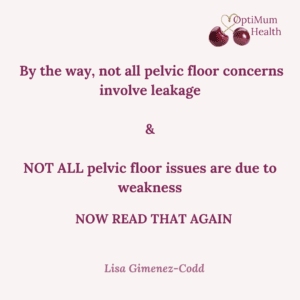Read this before investing in a pelvic floor toner.
If things have been feeling a little different “down there” recently, you may be considering investing in a pelvic floor toner. The options are many –
- vaginal eggs,
- weights
- vaginal cones
- electrical stimulation and
- devices connected via bluetooth to your phone.
But do they work?
Are they a magical solution to
- prevent urinary leakage?
- protect your prolapse?
- support your pelvic floor?
Many women purchase a pelvic floor toner when they get fed up of leaking urine when they sneeze, cough, laugh or jump. For my free guide on how to sneeze, cough and laugh without leaks, please click here.
So, do you even need a pelvic floor toner?
Let’s dive in and find out – you can watch the video below or scroll down further to read the blog.
What is a pelvic floor toner?
A pelvic floor toner essentially is a device that you insert into your vagina to support pelvic muscle activity. It can stimulate activity or help you work on controlling contractions and releases of your pelvic floor muscles. These muscles – your pelvic floor – work like a hammock or sling in the base of your pelvis.

Why might you consider a pelvic floor toner?
Now there are plenty of adverts out there for various different types of pelvic floor toners. They often make grand promises about eradicating those pelvic floor symptoms you’re experiencing.
Any woman that has concerns about her pelvic floor, or has encountered some urinary leakage, ( or perhaps faecal leakage) may consider pelvic floor toners to “build strength”.
Maybe there’s a feeling of heaviness or dragging through your pelvis.
Maybe just the stage of womanhood that you’re going through is creating changes in how your pelvis feels and you think,
“Oh, do you know what? I’m going to take action here before something happens!”
Certain particular times in a woman’s life may seem more relevant
- after having a baby or
- when you’re going through menopause.
And for some of us older mums, those two periods can overlap as well.
You may start going through perimenopause, not long after giving birth if you’re what’s delightfully classed as an “older mother”.
Do you need a pelvic floor toner of any description to be able to “tone” your pelvic floor?
Well this is where my first word of caution comes in because suggesting that you need a pelvic floor toner to deal with any pelvic floor concerns presumes that all pelvic floor issues are due to weakness.
They are not!
Strengthening a pelvic floor with a pelvic floor toner when it actually needs to learn how to release and relax can actually WORSEN symptoms.
What’s the best first step?
My top recommendation is to visit a female health physiotherapist. And the reason for this is that a female health physiotherapist can actually do a full assessment of what’s going on in your pelvic floor and they are best placed to identify whether you actually need:
- to follow a strengthening program (think squeezing & tightening) or
- to focus more on releasing, relaxing and letting go,
plus they will be able to give you more information about any sensations that you’re experiencing through your pelvis.
So if there are
- any heaviness or dragging sensations,
- if you are encountering leakage as well or
- maybe you’ve been diagnosed with a prolapse
and you’re thinking, “well I’ll strengthen my pelvic floor to help with what I’m feeling” – first find out whether strengthening is the best first option for you.
A word about prolapse
Sometimes that feeling of heaviness or bulging may be a sign of a prolapse. There are a number of types of prolapse but it’s essentially where one or more bodies within the pelvis falls or leans into the vagina. Whether that’s a prolapse of
- the bladder,
- the rectal canal,
- the cervix or womb
- part of the small intestine.
So when it comes to prolapse, my first recommendation is to ask whoever’s told you that you’ve got a prolapse, what type of prolapse they think that you’ve got.
And then again, ask for a referral to a female health physio who can confirm the diagnosis of prolapse or maybe offer an alternative view.
They will also give you more information on the stage of prolapse that you’re experiencing. The “bulge” may be quite mild and be completely internal or you may experience that bulge pushing out of the vagina.
And from that they will be able to help identify a bespoke plan for supporting your pelvic floor.
Pelvic floor problems are not just about weakness

When training the pelvic floor we need to understand to what degree we need to strengthen and to what degree we need to relax. And even when we are focusing on the strengthening aspects, there are two different types of muscle (fibre) within your pelvic floor.
I refer to them as Usain Bolt versus Mo Farah muscle fibres. 😄
There are quick fire fibres within your pelvic floor that act quickly in times of “emergencies” such as a cough, that laugh, that sneeze.
Whereas there are other fibres within your pelvic floor that are more about endurance. These support you and the organs above throughout the day.
This can also be why your pelvic floor squeezing may not feel as strong at the end of the day as they did at the beginning of the day – because your pelvic floor is working all day long and gets tired just like any other muscle.
Your pelvic floor engagement won’t feel as strong if you haven’t slept well. Because if you’re tired, so is your pelvic floor. And all of this is what can be taken into account by female health physio and also with Coaches such as myself, and other Holistic Core Restore® – coaches.

What comes next?
So first step then is seek the advice of a female health physio to understand what is actually going on with your pelvic floor. The second thing, it’s to understand how to do your pelvic floor muscle exercises properly. A number of years ago now, women were encouraged to “stop the flow of wee” as a way to judge whether your pelvic floor muscles were tightening and you could control that movement.
Now we don’t want you to do your pelvic floor engagement activities whilst urinating for one simple reason. Stopping and starting the flow of wee is going to disrupt the flow of urine from the bladder. That can cause issues such as interrupting the reflex of the bladder to release the urine, but also to incomplete emptying of the bladder. This can sometimes give rise to urinary tract infections and other discomfort.
So whilst it can occasionally be useful to just try and stop the flow of wee to see if you’ve got that control, actually it’s not the best place to do it. And certainly please don’t do your pelvic floor exercises whilst using the toilet.

Understanding how to do those pelvic floor exercises is about finding the cue that works best for you. Do you get the strongest feeling of engagement when you’re tightening around your back passage or when you’re tightening around the vagina?
What would work for you?
I use a huge range of different visualisations when I’m working with women on my courses so that they find the one that that makes the most sense to their brain. This is so they can visualise it in their head as they’re actually doing the exercises, to help them to feel that stronger engagement.
But again, importantly with doing any pelvic floor exercises, it’s important to not only be able to feel the tightening and lift, but also to feel the release and relax.

And that ties in actually to my favorite pelvic floor visualisation, which is why my logo is cherries 🍒 and it is imagining (and let’s just make sure it’s just imagining) that as you exhale, you are taking hold of a cherry with your vagina, drawing it gently up inside. Then as you breathe in, lower it down and let it go.
What do you need?
When working with clients, I combine that visualisation for the pelvic floor and coordinating this with the breath, so that the top and the bottom off your core cylinder are supporting each other. But I’ve mentioned already there are two different types of muscle fibre within the pelvic floor – so which type of pelvic floor exercises are going to be most effective for you?
Is it going to be those quick squeezes to help the fast twitch fibres (or the Usain Bolt elements). Or is it the long hold and continue to hold? – maintaining that contraction over time while still breathing and then releasing again under control.
Maybe it’s elements of both of those that you need to focus on, but it’s understanding how to do that exercise properly and understanding which elements are most relevant for you.
A pelvic floor toner will not appreciate this individually different needs. What’s more, often I work with women who feel they have to squeeze so hard that they feel aching in their vagina, pelvis and even back after using them. More on this in a mo.
Pelvic floor fails
A number of things I see when I first start working with ladies, they’re bobbing up and down on their chair, squeezing their buttocks rather than getting that internal contraction of the pelvic floor.
There’s always quite a strong link between the pelvic floor and the eyebrows too though I haven’t scientifically proven that yet. 😜
Something else that I see happen is a tilt of the pelvis rocking backwards, tucking the tailbone under as a way of stimulating the movement or feeling of connection within their pelvic floor.
Now these aren’t “fails” as such but ways women use to feel a stronger sensation through their pelvis whilst doing pelvic floor exercises. No-one really talks about how strong it should feel. There is no 1 answer to that either.
Do you know how hard to squeeze?
There isn’t a need however to squeeze as hard as you can every time – we’re looking for control over the muscles through any available range of movement – just the same as we would with any other area of the body.
In using a pelvic floor toner, women may be so fixated on achieving the points, dots, lines, beeps or feedback required from their device that they
- overdo the squeezing, leading to discomfort, aches and even pain afterwards
- don’t fully relax the pelvic floor between squeezes
Effective pelvic floor training is about supporting women to be able to feel that gentle tightening and lifting inside, as well as a controlled release and relaxation. And certainly when we’re looking at the endurance element of the muscles, we don’t want to be squeezing the life out of our pelvic floor for as long as possible and holding onto that for an extended period of time. There are different ways to approach the exercises and there are different levels of intensity that you may want to work at as well.
My personal pelvic floor journey
On my personal pelvic floor journey release was, & still is, the magic word. I am someone who tends to hold on to abdominal & pelvic floor muscles a little bit too.
Coaching Pilates means I’m working through my abdomen and pelvic a lot of each day. Over time these muscles can fatigue. So I have conscious triggers to allow me to let that go, or to remind myself to let that go.
Now, even if that isn’t the primary focus of your pelvic floor training needs, it’s still important for you to be able to fully release the pelvic floor. And this is for a couple of reasons.
It can be tricky to understand the difference between just relaxing the pelvic floor versus pushing down into the pelvic floor (which we don’t want). A pelvic floor toner may actually help with this – to focus on squeezing hold and then letting go, rather than on pushing it out of the vagina.
Does your pelvic floor drop like a stone?
There are some beautiful release positions for the pelvic floor that you can ease your body into. You can then take slow, steady breaths and they allow the muscles of the pelvic floor to release. Even if this isn’t the primary focus of what your pelvic floor needs, it is still important to be able to easily and fully relax your pelvic floor.
If we’re not fully relaxing the pelvic floor and we’re not going to get the best contraction in strengthening our pelvic floor either. It would be a little bit like doing half a bicep curl the time or only going halfway up a step all the time.
It’s important we can work the full range that is available to those pelvic floor muscles and also to give them some downtime. You know, if you think about any form of exercise that you do, you probably have a bit of a stretch off at the end of it.
Why would your pelvic floor muscles be any different?
Your pelvic floor sometimes needs to stretch too!
So again, it’s really important to include that. Now with pelvic floor toners, often the emphasis is largely on the tightening, the squeeze, the lift. The release and relax kind of gets a little bit bypassed.
How pelvic floor toners can really help
Pelvic floor toners can give a lovely tactile way to help you feel what is going on with your pelvic floor. They give you something to hold onto with the vagina that gives you something to let go of.
Sometimes that’s a lot easier if there’s something tactile inside the vagina to help us to feel what’s going on.
A free alternative
Now if you don’t want to buy a pelvic floor toner but you do like the idea of having something to hold onto and let go of, then there are other things you can use. Obviously with clean hands you can use one or two fingers, or a thumb.
Maybe you could do this with your partner and involve them in the process. Although that may sound a little bit icky, it can actually be a way to help you to talk about what’s going on for you with your partner. This can build support and you can actually have fun with it.
If you do use any sex toys, these may provide something to hold onto and to let go of. That touch can help you to get that feedback as to how your pelvic floor is feeling that you can then talk about with your female health physio.
Will your pelvic floor toner just get stuck in a drawer?
Being realistic with yourself, if you buy yourself a pelvic floor toner, how often are you actually going to use it?
How consistent are you going to be over time?
If you’re being honest with yourself, I think you’ll recognize that you’re probably use it quite actively, certainly when you first get it. But over time, this “enthusiasm” may dwindle. Life will get in the way – and you may easily find it harder to fit it in (pun intended! 😜)
How likely are you to keep this up over time?
Taking care of your pelvic floor is not a 5 minute job.
I always ask my clients:
“How long would you go without brushing your teeth?” – not even 24 hours right?
Pelvic floor support works best with that same level of consistency. You don’t struggle to fit in brushing your teeth do you? And you manage to do that twice every day too, right?
So what if we used that same approach for your pelvic floor exercises?
You may be more likely to do this if you’re not relying on inserting a device to get your pelvic floor working.
Simple apps like NHS’ Squeezy app can help remind you to do your pelvic floor exercises too. I recommend my clients identify triggers in their day to remind them to work on their pelvic floor for a few minutes. Examples of triggers are:
- boiling the kettle
- adverts coming on the TV
- waking up in the morning and getting into bed at night
- baby’s sleep time
- at work, whenever you get up to retrieve something from the printer (or whatever is relevant to you)
Why your pelvic floor needs the gym
Using a pelvic floor toner is not like a workout in the gym. You’re not going to be there using it for an hour at a time! How we support our pelvic floor outside of the time that we use any kind of toning support is really important.
Think about it – when you experience those unwanted leaks, bulging or heaviness, you’re moving right? Even just a sneeze or cough, causes a movement through our body – and a change in pressure.
The solution to your pelvic floor woes can’t focus solely and completely on the pelvic floor alone – we need to coach your pelvic floor
- in different positions
- during movement

For your long-term health it’s important that you can move with confidence.
Lift what you need to.
Jump when you want to.
Life isn’t spent on your back with your knees bent clutching a device with your vagina.
Life is dynamic, moving, spontaneous and exciting.
It’s important we look at ALL the factors that affect your pelvic floor health, beyond just the pelvic floor muscles themselves:

and it’s important to coach that pelvic floor connection whilst you move.
It is crucial that we train your pelvic floor in the context of movement within your whole body. This is what I do within my courses. That could be
- in the gym,
- to support you going for a run,
- doing Pilates or yoga,
- enjoying Zumba or HIIT
- lifting weights
- jumping on the trampoline with your children
It’s about coaching you through movements that are going to support your overall health and fitness. Your strength and balance too. But with your pelvic floor at the heart of those movements so that no matter what type of movement you’re doing, you can move without worrying about pelvic floor symptoms.
You can cough with confidence and there’s no more sneeze pee* either.
The link between pelvic floor issues & back pain
Also recognise that a recent study investigating lower back pain found that over 95% of the participants had some form of pelvic floor dysfunction.
Now that’s not saying pelvic floor dysfunction causes back pain, nor is it saying back pain causes pelvic floor dysfunction. But it’s interesting that the two happen together, both as co components of your call. So working your pelvic floor, in conjunction with movement and alignment, and your breath is the best way to support your whole body. Proactively dealing with any concerns about your pelvic floor.
Do you need a pelvic floor toner?
It’s not essential.
And certainly not the first thing I would recommend.
As you’ve seen for me, blathering on in this blog, that there are a number of steps that you can take that don’t require that investment in a pelvic floor toner.
Pelvic floor toners can be helpful for some, while for others they lead to discomfort or symptoms increasing. Or they can just end up stuck in a drawer.
Your best investments will be in seeing a female health physio and or a Coach such as myself so we can support your pelvic floor through movement for whatever stage of womanhood you’re currently at.
If you’ve got any questions with any of the points that I’ve discussed, and please don’t hesitate to get in touch. If I can, I will help you. And if I can’t, I will do my best to forward you on to whoever I can provide the best support.
In the meantime, if you’d like a free guide to avoiding leaks when you sneeze, cough or laugh, please do click here.
Lisa Gimenez-Codd is a Mum of 2 boys and a Women’s Health Coach who is passionate about empowering women to feel strong in their bodies, from the inside out through pregnancy, post-natal, peri- & post menopause. She believes that women hold a great deal of potential for power in their pelvis, and when this area doesn’t feel right it steals our confidence. Women take, on average, over 6 years to seek help for pelvic floor problems. Lisa believes every woman deserves to understand what’s happening in this area of our bodies and how to support it.

